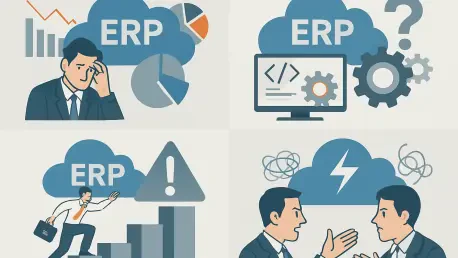Imagine a global corporation, on the brink of a major digital overhaul, investing millions in an ERP cloud system to streamline operations across continents, only to face a staggering failure rate—studies suggest up to 70% of such implementations encounter significant setbacks. This alarming statistic underscores the high stakes involved in adopting cloud-based Enterprise Resource Planning (ERP) solutions, which promise scalability and efficiency but often deliver costly disputes and operational disruptions. This review delves into the intricacies of ERP cloud implementation, examining its features, challenges, and real-world performance to provide a clear picture of its current state in the technology landscape.
Core Features and Technological Shifts
ERP cloud systems serve as integrated software platforms hosted on cloud infrastructure, designed to manage critical business processes such as finance, human resources, and supply chain operations. Unlike traditional on-premise systems that required extensive customization, these solutions offer a mass-market approach, providing standardized functionalities accessible via the internet. This shift from custom to cloud-based models has enabled organizations to scale operations rapidly while reducing the burden of maintaining physical IT infrastructure.
A notable evolution in this space is the adoption of agile and hybrid deployment frameworks, replacing the rigid waterfall methodologies of the past. These modern approaches prioritize iterative development and flexibility, allowing businesses to adapt implementations to changing needs. The result is a technology that supports rapid deployment, often aligning with market demands for quicker time-to-value, though this speed sometimes comes at the expense of thorough planning.
The relevance of ERP cloud systems cannot be overstated in today’s digital economy. They empower organizations with real-time data access and operational agility, fostering collaboration across geographically dispersed teams. However, the transition to these platforms introduces complexities that demand careful navigation to fully harness their potential.
Key Challenges in Deployment
Timing Pressures and Solution Validation
One of the most pressing issues in ERP cloud deployment is the intense pressure to implement solutions swiftly, driven by market expectations and competitive demands. This “timing imperative” often compresses the period available for due diligence, leading to insufficient validation of the chosen solution against organizational needs. Without rigorous pre-contract assessment, companies risk entering multi-year commitments with limited recourse for mismatches in functionality or performance.
The consequences of inadequate validation are significant, as contracts are frequently signed before critical gaps are identified. This rushed approach can result in financial obligations for systems that fail to meet expectations, with little room for renegotiation or exit. Organizations must prioritize comprehensive solution vetting to mitigate these risks, even under tight deadlines.
Implementation Scope and Contractual Ambiguities
Another critical challenge lies in defining the scope of implementation through Statements of Work (SOWs), which often contain vague language and unclear responsibilities. Terms like “assist” or “support” in SOWs can create misunderstandings, with providers claiming limited liability for outcomes while clients expect more hands-on involvement. Such ambiguities frequently lead to disputes and unexpected cost overruns during the project lifecycle.
Specific areas such as data migration, user acceptance testing (UAT), and organizational change management are particularly prone to underestimation by clients. Data migration, for instance, often requires far more effort than anticipated, resulting in early change orders and delays. Similarly, managing UAT and change initiatives without adequate internal expertise can derail timelines, emphasizing the need for precise contractual delineations and realistic capability assessments.
The impact of poorly scoped SOWs extends beyond immediate project delays, often straining relationships between clients and providers. Addressing these issues requires meticulous attention to contract details and a clear understanding of each party’s obligations, ensuring that both sides align on expectations from the outset.
Market Dynamics and Negotiation Hurdles
Market tactics in the ERP cloud space often exacerbate deployment challenges, with providers leveraging artificial pricing deadlines to rush clients into agreements. These tactics exploit the timing imperative, pressuring organizations to sign subscription contracts before fully negotiating implementation terms. The result is diminished leverage for clients, who may face ticking subscription costs while still finalizing critical SOWs.
Additionally, the prevalence of insufficiently scoped time-and-materials (T&M) engagements or deceptive fixed-fee arrangements poses substantial financial risks. Cost overruns in these scenarios are not uncommon, with change orders sometimes rivaling the original project budget. Competitive leverage during negotiations emerges as a vital tool, allowing clients to push back against unfavorable terms and secure more balanced agreements.
Navigating these market pressures demands a strategic approach, including maintaining multiple provider options until key deal objectives are met. By resisting sales-driven deadlines and advocating for contractual rigor, organizations can better protect themselves from the pitfalls of one-sided terms and unforeseen expenses.
Real-World Performance and Industry Impact
Examining real-world applications of ERP cloud systems reveals a mixed landscape of successes and setbacks across industries. For instance, a global corporation integrating a strategic acquisition successfully negotiated flexible subscription quantities over a multi-year ERP commitment, allowing adjustments as needs evolved during deployment. Such tailored strategies demonstrate how foresight can mitigate implementation risks.
Conversely, numerous cases highlight the operational fallout from failed implementations, where misaligned expectations and unclear terms led to significant disruptions. Industries ranging from manufacturing to healthcare have experienced project delays and budget overruns, underscoring the importance of thorough planning and stakeholder alignment in achieving positive outcomes.
These examples illustrate the transformative potential of ERP cloud systems when executed effectively, as well as the severe consequences of oversight. The operational impact—whether streamlining processes or causing costly interruptions—depends heavily on the quality of preparation and negotiation invested in the deployment process.
Barriers to Adoption and Ongoing Limitations
Several barriers continue to hinder successful ERP cloud adoption, with technical challenges like data migration complexities topping the list. Migrating legacy data to cloud platforms often involves intricate cleansing and mapping processes that overwhelm internal teams lacking specialized expertise. This technical hurdle frequently results in project delays and additional costs.
Regulatory compliance also poses a significant obstacle, as organizations must navigate varying data protection and industry-specific requirements across regions. Market-driven pressures further complicate adoption by discouraging thorough vetting of terms, while internal capability gaps in areas like UAT and change management exacerbate implementation struggles. Efforts to enhance contractual clarity and stakeholder coordination are underway to address these issues.
Beyond technical and regulatory concerns, cultural resistance to change within organizations often undermines adoption. Aligning diverse stakeholder groups with competing priorities remains a persistent challenge, necessitating robust communication strategies to ensure buy-in and minimize friction during transitions.
Future Trends and Technological Advancements
Looking ahead, the trajectory of ERP cloud systems points toward significant advancements in integration tools and contractual frameworks aimed at resolving current shortcomings. Enhanced tools are expected to streamline data migration and system interoperability, reducing technical barriers that plague deployments today. These innovations promise to make implementations more seamless over the coming years.
Contractual frameworks are also evolving, with a push for greater transparency and accountability in SOWs and subscription agreements. As organizations adapt to the accelerating pace of cloud deployments, there is a growing emphasis on building internal capabilities and fostering strategic partnerships to manage complex implementations effectively.
The long-term impact of these trends on business operations will likely be profound, as ERP cloud systems become increasingly integral to digital transformation strategies. Staying ahead of these developments requires proactive adaptation, ensuring that technological reliance does not outpace organizational readiness.
Final Reflections and Path Forward
Reflecting on the extensive analysis, it becomes evident that ERP cloud implementations carry immense potential but are fraught with challenges that demand meticulous attention. The high failure rates and costly disputes that mark many projects serve as stark reminders of the stakes involved in these endeavors.
Moving forward, organizations need to prioritize actionable strategies such as allocating ample time for solution validation, engaging independent experts for unbiased assessments, and ensuring executive involvement in defining clear objectives. Establishing competitive leverage by considering multiple providers until critical terms are secured proves essential in negotiations.
Additionally, fostering a culture of rigorous contractual scrutiny and stakeholder alignment emerges as a cornerstone for success. By investing in these areas, businesses can navigate the complexities of ERP cloud systems, turning potential pitfalls into opportunities for operational excellence in subsequent deployments.









